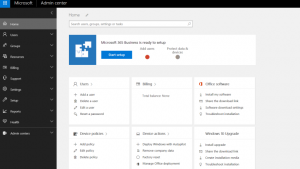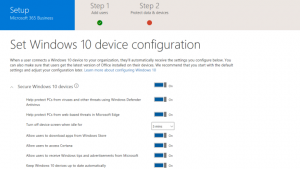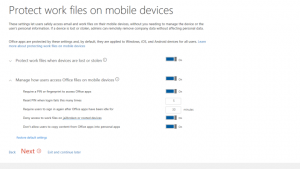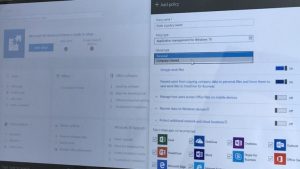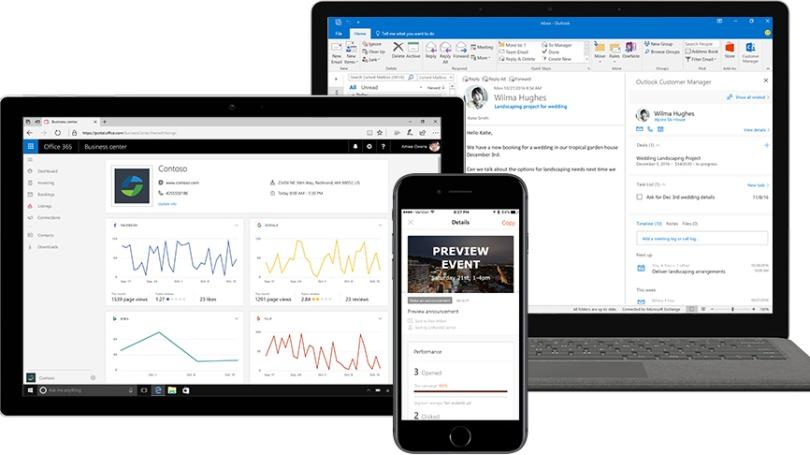
Microsoft 365 Business could become the only platform your small business needs to run daily operations. Generally available starting today in the US, UK, and Canada, Microsoft’s new holistic cloud solution for small to midsize businesses (SMBs) combines full versions of Windows 10 Pro and Office 365 with a new centralized admin dashboard to oversee a full range of IT functions. From a unified dashboard, small businesses can manage everything from security groups and user policies to device configuration and remote data wipe from company devices.
More importantly for small business owners and managers, Microsoft 365 Business also comes with a suite of new SMB applications that dramatically simplify how small businesses can manage invoices, email marketing, and company listings across Bing, Facebook, Google, and Yelp.
Priced at $20 per user per month for up to 300 users, Microsoft 365 Business pulls in the default Office apps as well as Exchange, Outlook, Microsoft Teams, OneDrive, and SharePoint, bundled with access to the Microsoft Admin Center for the aforementioned IT management console. The solution does require Windows 10 Pro installation ($199.99) on company machines, but the per-user price includes everything you get with Office 365 Business Premium ($12.50 per user per month). It also includes centralized IT, security, and device management controls.
Beyond simplifying IT management for small businesses, the disruptive value here is in the handful of new SMB-oriented cloud apps you get with Microsoft 365 Business. The focal point is a dashboard called the Microsoft Business Center. It features more than half a dozen apps, including the new Microsoft Listings, Microsoft Connections, and Microsoft Invoicing apps, and optional access to Microsoft Booking, the MileIQ mileage tracking app, and Microsoft StaffHub shift scheduling apps, depending on your business needs.
Microsoft Listings helps businesses manage their digital presence and information across channels. Microsoft Connections lets you quickly build and blast out email marketing campaigns from a selection of templates. Microsoft Invoicing, which also includes a mobile app for Android and iOS, syncs with QuickBooks$39.95 at Intuit and integrates with PayPal to help businesses quickly collect revenue and stay on top of past due invoices and payments. We got a closer look at all three, which you can find in our hands-on with the new SMB apps.
Contacts in the Microsoft Business Center can also sync with Outlook Customer Manager, the company’s pared down customer relationship management (CRM) app for automating customer data organization and sales interactions within Outlook. In place of subscribing to the scores of third-party services available, Microsoft is angling to become a one-stop-shop for SMBs.
“Microsoft 365 Business is a brand-new holistic solution that combines the productivity and collaboration tools you need to empower employees, the business apps to grow your business, and management and security tools tailor-built for small businesses,” said Caroline Goles, Director of Office Small Business Marketing at Microsoft. “We’ve taken all of that and wrapped it in a single solution to simplify IT for SMBs.”
What’s in Microsoft 365?
In Microsoft’s growing catalog of similar-sounding business cloud services, the names can get a tad confusing. At its Inspire conference in July, the company announced Microsoft 365, its combined offering that packages Office 365$6.99 at Microsoft, Windows 10, and Microsoft’s enterprise mobility and security services into a cloud-based suite for businesses. Microsoft 365 comes in both Business and Enterpise versions.
A month later at Ignite, the tech giant announced two more versions: Microsoft 365 Education and Microsoft 365 F1. The latter version is one specifically for “first-line workers” that includes retail salespeople, customer service reps, factory workers, and medical staff. Microsoft 365 F1 included purpose-built apps such as Microsoft StaffHub which, as of today, is also available in Microsoft 365 Business and Office 365 Business Premium subscriptions.
So that leaves us with four total flavors of Microsoft 365: Business, Enterprise, Education, and F1, all of which are now generally available. Microsoft 365 Business was the last to reach GA but is also the simplest in its execution. Goles said the idea was to give small businesses the most functionality in the most streamlined interface.
“There’s a need for unique solutions for certain business types and businesses sizes. Nowhere have we found a greater opportunity to take a rich commitment in those solutions than in small business,” said Goles. “Small businesses have the ability to harness digital transformation because they’re agile and nimble. But there’s also uniqueness in their challenges. Many SMBs don’t have dedicated IT departments to manage infrastructure, so they’re trying to figure out how to take advantage of technology while managing costs.”
The SMB Admin Center
Microsoft showed off its new small business offering at a press event in New York City last week. Goles and Gabe Long, Senior Product Marketing Manager at Microsoft, demonstrated the IT admin features of Microsoft 365 Business as well as the new Listings, Connections, and Invoicing apps. We did a deeper dive with the SMB apps in our hands-on (linked again at the bottom of this story). So here we’ll focus on what you can do in the Microsoft Admin Center.
For small businesses, the admin console simplifies dozens of different settings and workflows into a simple interface. The Microsoft Admin Center is laid out similarly to the admin dashboard in Office 365, managed largely by simple buttons and on/off sliders for different admin settings. There are primary menus front and center for overseeing users, device policies, device actions, domains, Office software, billing, and upgrades (plus support and help videos).
Long went through most of the basic IT admin functionality. One of the more nifty capabilities is how simple Microsoft 365 Business makes file management and data access controls, with a lot of intelligence under the hood. An admin can set data policies such as automatically deleting work files from an inactive device after 7 days, for example, or enforcing a PIN when accessing particular apps. On Android and Surface devices that have MicroSD cards, admins can also choose the option to encrypt all files store on a mobile device. The system also automatically installs all Windows 10 updates, especially pertaining to security updates for Windows DefenderBuilt in to Windows 10 at Microsoft
To prevent data leaks, the small business can even set policies such as not letting a user copy content or save data from office apps to personal apps. Admins can also force users to save files to vetted storage apps such as OneDrive for Business$5.00 at Microsoft. Long demonstrated trying to save a work document to a personal Dropbox account that is not sanctioned by IT. His attempted triggered a “Save Not Allowed” message with the description, “Your IT policy doesn’t allow you to save a file to this location.”
He also simulated a user copying work data and trying to paste it into a new email in a personal account. Instead of pasting the content, the action pastes a message from IT in the email body stating, “Your organization’s data cannot be pasted here.” All of this can be managed from the Device Policies and Device Actions section of the admin dashboard. In this instance, they can be managed by simply clicking the toggle for the setting, “Don’t allow users to copy content from Office apps into personal apps.”
This works the same way when configuring device policies or setting up various user groups to control data and app access. You can’t configure user-access policies and individual device permissions as granular as you could with a full-blown enterprise device management platform such as Microsoft Intune$6.00 at Microsoft. But Long said that the point with Microsoft 365 Business is to make sure IT management for small businesses is as uncomplicated as possible.
According to Long, Microsoft 365 Enterprise currently has seven different admin consoles across security and compliance, Intune, Microsoft AzureLearn More at Microsoft, etc. The company’s goal is for this simplified toggle-based admin dashboard to be rolled out across all of its Microsoft 365 experiences. But for now it’s only in the SMB offering.
There’s a lot more you can do with simple IT management in Microsoft 365 Business. However, Goles and Long both stressed the speed at which SMB admins can set up new machines and wipe data from a lost, stolen, or de-provisioned device. The company had SMB customer North Carolina-based Garner Foods, which has about 120 employees, on hand to drive this point home. When onboarding a new employee, the admin center’s automated settings and device policies cut down deployment time for a new employee’s device from a day and a half to a few hours, according to Garner’s chief operating officer.
“That first day of employment twiddling your thumbs goes away,” said Goles. “You get employees up and running right away, and make sure all the settings are ready to go for them in a really simple way.”
To wipe a company device, you simply go into device actions, click the “Removing Company Data” option, select the device, and click “Remove.” So, in the event that a device is lost, stolen, or an employee leaves the company, all business data can be wiped from that device within five minutes rather than using third-party software or even having to physically locate the device.
Cornering the Small Business Market
Microsoft has spent decades selling software to businesses. The tech giant’s Windows$119.99 at Microsoft, Office, server, and developer products have generated billions in revenue primarily by targeting larger enterprise customers to complement its consumer-side sales. Microsoft has always sold plenty to SMBs, too, but rarely with purpose-built solutions designed for those local businesses comprising the bulk of the US economy. In the cloud-driven Satya Nadella era, the company is going hard after the small busines market with a growing set of integrated apps and tools to undercut third-party competitors.
If a small business is already buying Windows PCs and Microsoft software, then the tech giant is putting itself in a prime position to help manage a host of other daily SMB operations as well. To all of the MailChimps and Xerosand the hundreds of other low-cost cloud services out there that thrive on small business subscriptions: Microsoft 365 Business is coming for your customers.
For a closer look at what the Microsoft Listings, Connections, Invoicing, and StaffHub apps can do, check out our hands-on with new the SMB apps.

